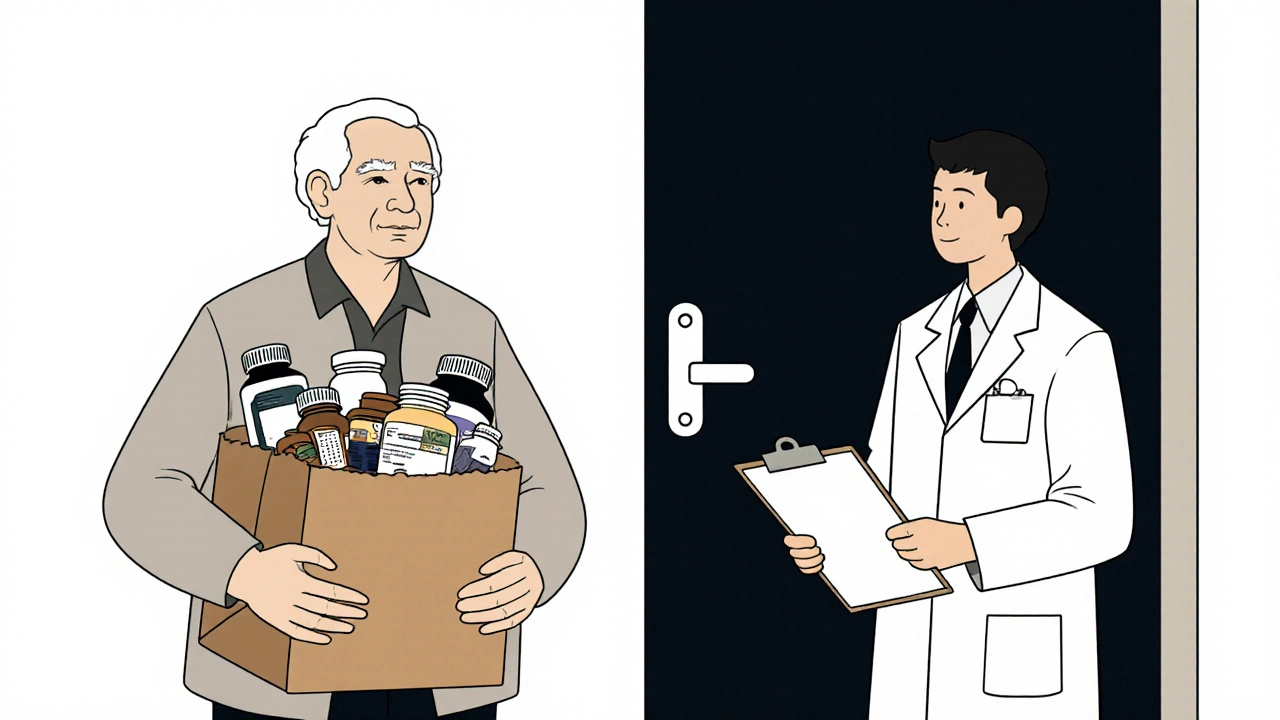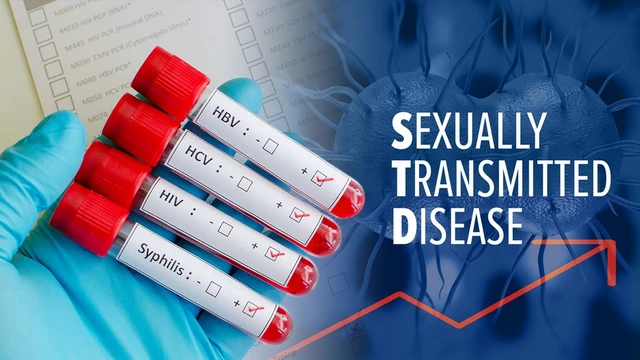How to Bring Pill Bottles to Appointments for Accurate Medication Reconciliation

- Colin Hurd
- 10 November 2025
- 9 Comments
Why Bringing Pill Bottles to Your Doctor Appointment Matters
Most people think they know what medications they’re taking. But when you sit down with your doctor and they ask, "What are you on?" - you might freeze. You remember the big ones: blood pressure, cholesterol, diabetes. But what about that little white pill you take only when your knee flares up? Or the vitamin you started six months ago and forgot to mention? The truth is, medication reconciliation - the process of matching what you say you take with what you actually take - fails more often than not. And it’s not because you’re careless. It’s because memory is unreliable. That’s why bringing your actual pill bottles to your appointment isn’t just a good idea - it’s the single most effective way to prevent dangerous mistakes.
The Real Risk of Getting It Wrong
Medication errors are one of the leading causes of preventable harm in healthcare. In Australia, around 1 in 5 hospital admissions for older adults is linked to a medication problem. In the U.S., the numbers are even starker: 18% of primary care visits involve a medication discrepancy, and 5% of all hospital admissions are due to adverse drug events. Many of these happen because doctors are working from incomplete or outdated lists. A 2023 study found that 60-70% of patients have at least one error in their medication list during care transitions - like moving from hospital to home, or switching doctors. These aren’t minor oversights. They’re life-threatening. Missing a blood thinner, doubling up on a sedative, or not knowing you’re taking two drugs that interact badly can lead to falls, kidney failure, or even death. The fix? Bring your bottles.
What Exactly Should You Bring?
You don’t just need your prescription meds. You need everything.
- All prescription medications - even if you stopped taking them last month
- All over-the-counter pills - pain relievers, sleep aids, antacids
- Vitamins, minerals, and supplements - even the ones you "only take once in a while"
- Herbal remedies and teas marketed as "natural" - many interact with prescription drugs
- Any pills in pill organizers, weekly trays, or divided containers
Why include expired or discontinued meds? Because your doctor needs to know what you’ve stopped - and why. Maybe you ran out and didn’t refill. Maybe you felt worse and quit. Maybe your last doctor told you to stop, but you never told your current one. Without the original bottle, they can’t verify what you were taking, how much, or when you stopped. And that gap is where errors creep in.
Why Original Containers Are Non-Negotiable
Many people transfer pills into pill boxes to make life easier. It’s practical. But it’s also dangerous for reconciliation. A 2023 study found that 38% of patients consolidate their meds into single containers. That means your doctor sees a little white pill in a plastic tray and has no idea if it’s aspirin, a statin, or a thyroid pill. Original bottles have the exact drug name, strength, dosage instructions, pharmacy name, and expiration date - all required by law. Without that label, you’re guessing. And guessing with meds is risky. Even if you think you remember, your memory is likely wrong. Studies show people misremember their dosages up to 40% of the time. The bottle doesn’t lie.
How to Prepare: A Simple 15-Minute Routine
You don’t need to be a nurse to get this right. Just follow this simple plan:
- 24 hours before your appointment, gather every bottle, box, and packet you have at home.
- Don’t throw anything away - not even empty bottles. Take a photo of the label if you’ve already tossed it.
- Put everything in a single bag - a grocery bag works fine. This is called the "brown bag review," and clinics that use it cut reconciliation time by 38%.
- If you use a pill organizer, bring it too - but also bring the original bottles so your provider can match what’s inside to what’s on the label.
- Write down any questions: "Why am I taking this?", "Is this still needed?", "Can I stop this one?"
Some people feel embarrassed bringing a bag full of pills. Don’t. Your doctor has seen it all. They’re not judging you - they’re trying to keep you safe. One nurse in Perth told me she once found a patient was taking two different blood thinners because two different doctors had prescribed them. Neither knew. That’s the kind of thing a brown bag review catches.

What If You Use a Pill Organizer?
If you rely on a weekly or monthly pill tray, you’re not alone. But you’re also at higher risk of errors. Studies show 77% of older adults use these organizers - but only 23% keep meds in original bottles. That’s a red flag. Your doctor needs to see the original label to confirm the medication, dose, and frequency. Bring both: the organizer for convenience, and the bottles for accuracy. If you’re worried about clutter, take photos of each bottle label before you refill your organizer. Store them in your phone’s notes app. That way, even if you lose a bottle, you still have the info.
Telehealth Visits? Bring Your Bottles Anyway
Some people think, "I’ll just show my pills on camera during a Zoom call." But video checks miss a lot. A 2024 study found virtual verification misses 22% of discrepancies - especially when pills are unlabeled, organized in trays, or stored in unusual containers. Your doctor can’t tell if a pill is broken, discolored, or expired from a pixelated image. They can’t feel the texture of the bottle or read the fine print on the label. If you’re doing a telehealth visit, set up a well-lit space, hold each bottle up to the camera, and read the label out loud. But even then, don’t skip bringing the actual bottles to your next in-person visit. It’s still the gold standard.
What Happens When You Don’t Bring Them?
Doctors and nurses have to guess. They’ll check your pharmacy records, your EHR, your last prescription list. But here’s the problem: those records are often wrong. Pharmacies don’t always update when you stop a med. Doctors don’t always document changes. And if you switched providers, your old records might not have transferred. A 2023 analysis showed that when patients didn’t bring bottles, medication errors were 67% higher than when they did. That’s not a small difference. That’s the difference between staying healthy and ending up in the ER.
What About Digital Tools?
There are apps like Medisafe, Hero Health, and MyTherapy that track your meds. Some even sync with pharmacies. They’re helpful - but they’re not replacements. They rely on what you input. If you forget to log a supplement, or you misremember a dose, the app won’t catch it. The pill bottle? It’s real. It’s physical. It’s unchangeable. Digital tools are great for reminders and adherence - but for accuracy during a medical review? Nothing beats the bottle.

Why This Is Especially Important for Older Adults
If you’re over 65, you’re more likely to be taking five or more medications. That’s called polypharmacy. And it’s common - 47% of Australians over 65 take five or more prescription drugs. Each one adds risk. The American Geriatrics Society found that 56% of potentially harmful medications in older adults are only identified by physically checking the bottle. That’s because older patients often take meds for conditions they’ve forgotten about - like a past infection, a short-term pain issue, or a temporary side effect. Without the bottle, those meds stay on the list forever. And that’s dangerous.
What If You’re Afraid to Bring Unused Meds?
Many people feel guilty about bringing pills they haven’t taken in months. They think, "My doctor will think I’m non-compliant." But that’s not what happens. Doctors know people stop meds for all kinds of reasons - cost, side effects, forgetfulness, feeling better. Bringing those bottles gives your doctor the full picture. It helps them understand your real behavior - not just what’s on paper. One GP in Melbourne told me a patient brought 12 bottles, including several stopped years ago. That led to a conversation about why they stopped - and revealed a hidden depression. The doctor adjusted treatment, and the patient’s health improved dramatically. The bottles didn’t make them look bad. They made them heard.
What Your Doctor Will Do With the Bottles
When you bring your pills, your doctor or pharmacist will:
- Compare each bottle to your electronic record
- Check for duplicates - two prescriptions for the same drug
- Look for dangerous interactions
- Verify doses and frequencies
- Identify expired or discontinued meds
- Remove meds you’re no longer taking
- Update your list with new ones you’ve started
They’ll then give you a printed or digital copy of your updated medication list. Keep it in your wallet or phone. Use it for future appointments, pharmacy visits, or emergencies.
What to Do After the Appointment
Don’t just walk out with your new list. Do this:
- Ask: "What changed? Why?"
- Ask: "Which meds can I stop?"
- Ask: "When should I come back to review?"
- Update your phone app or paper list
- Keep the updated list with your pill bottles
- Dispose of unused meds properly - don’t flush them. Take them to a pharmacy drop-off.
Medication reconciliation isn’t a one-time thing. It’s an ongoing habit. Do it every time you see a new provider. Do it every six months if you’re on multiple meds. And always, always bring the bottles.
Final Thought: Your Bottles Are Your Safety Net
You don’t need to be perfect. You don’t need to remember every pill. You just need to bring the bottles. They’re the most honest record you have. They don’t forget. They don’t lie. They don’t get lost in a system. They’re right there in your hand. And when you hand them to your doctor, you’re not just handing over plastic containers - you’re handing over your safety. That’s why this simple step saves lives.
Do I need to bring every single pill bottle, even if I haven’t taken it in months?
Yes. Even if you stopped taking a medication weeks or months ago, bring the bottle. Your doctor needs to know what you’ve taken - and why you stopped. This helps them spot unnecessary prescriptions, avoid dangerous interactions, and understand your real medication habits. Discarded bottles are one of the biggest reasons reconciliation fails.
Can I just show my pills on my phone during a video call?
It’s better than nothing, but not ideal. Virtual checks miss 22% of errors - like unlabeled pills, expired meds, or pills in unusual containers. Your doctor can’t read small print, check expiration dates, or verify the pharmacy label on camera. For accuracy, always bring the actual bottles to in-person visits. Use video as a backup, not a replacement.
What if I use a pill organizer? Do I still need the original bottles?
Yes. Pill organizers are great for daily use, but they erase critical details like drug name, strength, and dosage instructions. Your doctor needs to match what’s in your organizer to the original bottle labels. Bring both - the organizer for convenience, and the bottles for accuracy.
Do I need to bring over-the-counter meds and supplements?
Absolutely. Many serious drug interactions happen with OTC meds and supplements. For example, St. John’s Wort can cancel out antidepressants, and ibuprofen can raise blood pressure. Even if you think it’s "just a vitamin," bring it. Your doctor needs the full picture.
What if I lost a bottle? Can I just tell them what it was?
Try to find the bottle or the pharmacy receipt. If you can’t, take a photo of the label before you throw it away next time. If you’ve already lost it, write down everything you remember - name, color, shape, how often you took it - and bring that list. But know this: your doctor will treat it as incomplete. That’s why keeping the original bottles is so important.
How often should I do a medication review like this?
At least once a year - and every time you see a new doctor or start a new medication. If you take five or more meds, or if you’re over 65, do it every six months. Medications change. Your body changes. Your needs change. Regular reviews keep your list accurate and your health safe.




Comments
Alex Ramos
Just did my brown bag review last week - brought 17 bottles, including that fish oil I stopped in 2022. My pharmacist laughed, then said, "You just prevented a stroke." 🙌
November 11, 2025 AT 08:21
Ryan Everhart
So let me get this straight - the entire medical system is built on trust and guesswork until you show up with a grocery bag full of plastic? Wild.
November 11, 2025 AT 13:04
Chrisna Bronkhorst
Same guy who told me to stop statins because "you’re not fat enough to need them" - then I brought my bottles and he realized I’d been on them for 7 years. Turns out he never updated my file. Classic.
November 11, 2025 AT 19:35
Alyssa Lopez
OMG YES. I brought my supplements and my doc found I was takin 3 diff meds that all raise BP. I thought turmeric was "just herbal". Turns out it’s a chemical bomb with my amlodipine. #MedSafety
November 11, 2025 AT 21:32
Amie Wilde
My grandma brings her pills in a Tupperware. We laugh. Then she dies. Don’t be her.
November 11, 2025 AT 23:12
edgar popa
just bring the damn bottles. its not that hard. your life is worth it.
November 13, 2025 AT 12:55
Eve Miller
If you don't bring your pill bottles, you're not just being negligent - you're endangering yourself and everyone in the healthcare system who has to clean up your mess. There's no excuse.
November 15, 2025 AT 08:26
Mark Rutkowski
It’s funny how we trust our phones to remember our last text, but we expect our brains to recall every pill we’ve swallowed since 2018. The bottle doesn’t care if you’re embarrassed. It just says: "I’m here. I’m real. I’m your truth."
That little white pill you forgot? It’s still in your body. That expired antibiotic? Still in your cabinet. That herbal tea you think is "harmless"? It’s probably metabolizing into something your liver regrets.
Your doctor isn’t judging you. They’re trying to untangle a mess you didn’t even know you made. The bottles are the Rosetta Stone - they translate your chaos into clarity.
I used to think bringing pills was for old people. Then I found a bottle of metoprolol I’d stopped taking after my panic attack - and my cardiologist realized I’d been self-medicating anxiety with alcohol. That bottle didn’t just save me - it saved my marriage.
It’s not about compliance. It’s about honesty. The body doesn’t lie. The bottle doesn’t lie. Only the memory does. And memory? Memory is a drunk poet with a thesaurus.
Bring the bag. Even if it’s full of ghosts. Even if you’re ashamed. Even if you think it’s too late. The system doesn’t care about your pride. It only cares if you’re alive tomorrow.
And if you’re still not convinced? Think of the person who didn’t bring their bottles. The one who got sent home with the wrong dose. The one who didn’t wake up. That could’ve been you.
So next time? Grab the bag. Walk in. Say nothing. Just hand it over. Let the plastic speak for you.
November 15, 2025 AT 23:32
David Barry
Author’s post is 98% correct but ignores one critical flaw: pharmacies don’t update EHRs in real time. I brought my bottles, doctor matched them, then went to print the list - and the system still listed a drug I’d discontinued 8 months ago because the pharmacy never synced. So now I carry a QR code on my phone linking to a Google Doc with scanned labels. The bottle’s the source. The doc’s the interpreter. The tech? The glitch.
November 17, 2025 AT 00:59